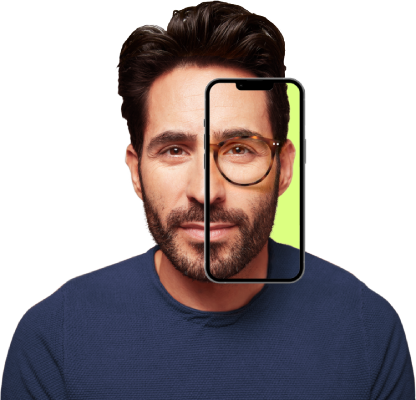
Our new virtual try-on tool lets you try on our latest styles anytime, anywhere!
Everything you need to know to take care of your eyes — for life.
Even if your vision is fine, getting eye care when you’re younger can help prevent or detect serious issues early. Your future eyes will thank you.

Taking care of your eye health in your 20s, 30s, and 40s can pay big dividends for decades to come. It can help lower your risk of vision-dimming cataracts and detect serious conditions early.
“Even if your vision is 20/20, you don’t know what’s going on in the back of your eyes,” explains Zahraa Khan, O.D., F.A.A.O., an optometrist at America’s Best Contacts & Eyeglasses in Cuyahoga Falls, Ohio. “I tell my patients it’s important to protect the health of your eyes with regular eye exams and other smart steps.”
So, what does that involve? These seven simple strategies can help safeguard your eyes against injury and help you see the world clearly — up close and at a distance.
Have questions about your eye health or vision? Your America’s Best optometrist is here to help. Click here to find an exam time that fits your schedule.
Think of eye exams like annual physicals or wellness screenings: By taking this preventive step, you can help maintain good vision and flag any developing issues.
In a comprehensive eye exam, an optometrist checks how well each of your eyes sees, of course. But it doesn’t stop there.
An eye exam evaluates depth perception, peripheral (side) vision, how well your eyes work together to focus, and eye pressure. The eye doctor will also look inside your eyes for early signs of eye diseases or other health conditions. And if you have diabetes or high blood pressure — which can cause damage to blood vessels in the retina — the optometrist will check for that too.
Generally, Dr. Khan recommends getting an eye exam at least every two years. But some people should have an exam every year, or even more often, according to the American Optometric Association. Here are a few reasons that might be necessary:
You’re at risk of vision problems due to a personal or family history of eye disease.
You have health conditions that could affect your eyes, such as diabetes or high blood pressure.
You’ve had eye surgery or have vision only in one eye.
In this case, when you don’t see something, say something! It’s important to contact an eye doctor when your eyes feel off. Get in touch right away if:
You wear glasses or contact lenses and you’re no longer seeing clearly.
Your eyes are red, swollen or painful.
You have double vision.
You notice any other changes that concern you, such as “floaters” or flashes in your field of vision.
Your eye doctor will check to see if there’s an injury, infection, or allergic reaction affecting your eyes and, if necessary, provide treatment. They’ll also assess whether what’s happening could be a warning sign of eye disease.
Our new virtual try-on tool lets you try on our latest styles anytime, anywhere!
Ultraviolet rays from the sun can cause damage that raises the risk of cataracts and age-related macular degeneration when you’re older, according to the National Institutes of Health. And those rays don’t stop shining when it’s cold out.
That’s why sunglasses aren’t just for summertime. Putting them on during bright daylight hours at any time of year can help protect your sight. Choose sunglasses with lenses that block 100% of the sun’s UVA and UVB radiation.
Recommended reading: The America’s Best Guide to Sunglasses
Certain home and workplace projects call for safety glasses. Home maintenance or repair projects could involve harmful splinters of wood, metal, or plastic (such as from drilling and sawing), Dr. Khan says. And if your job or specific workplace tasks could lead to eye injuries, be sure to follow eye-safety rules — they’re there for a reason.
For sports, be careful in games where other players or equipment — such as balls, bats, or racquets — could come in contact with your face. Sports-safe eyewear is more protective than everyday glasses, Dr. Khan notes. (Learn more about the sports most likely to cause eye injuries here.)
Computer, tablet, smartphone — many of us have one of each. And long periods of screen viewing can cause eyestrain, blurry vision, and dry eyes.
Keep your eyes comfortable by following the 20-20-20 rule, Dr. Khan suggests. “Every 20 minutes, look up from your screen at something 20 feet away for 20 seconds,” she says. If you’re doing this technique at work, make sure you don’t use the time to check your phone.
How does this break help? It lets the muscles that focus your eyes relax, for one. It also allows you to blink more frequently (we tend to blink less often while looking at the computer). Blinking bathes your eyes in soothing, protective natural tears.
Wearing makeup and contacts shouldn’t generally be an issue. But a few safety precautions can prevent these everyday basics from causing discomfort and even damage.
Always wash your hands before applying or removing eye makeup such as mascara, eyeliner, or eye shadow. This ensures that you don’t transfer any dirt or bacteria from your fingers into your eyes.
It’s also best to replace old products, especially mascara — which manufacturers generally recommend doing every two to four months. Doing so can prevent bacteria from breeding, particularly in a liquidy product like a mascara tube. And if you’ve had an eye infection, be sure to throw out any eye makeup you’ve been using, recommends the U.S. Food and Drug Administration. You don’t want to reinfect yourself.
With contact lenses, two basic steps help protect the surface of your eyes. As with makeup, it’s important to wash your hands before handling contacts, the National Eye Institute suggests. And unless you use daily disposable contacts[link to dailies hub, this batch], disinfect them each night and replace them as recommended by your eye doctor.
What you put on your plate can affect how you see. Certain foods may help lower your risk of age-related macular degeneration and cataracts, according to the American Optometric Association. By reducing inflammation, these foods may help keep blood vessels healthy and increase tear production.
Eye-healthy foods include:
Colorful fruits and vegetables, from tangerines, strawberries, and papaya to spinach, broccoli, and tomatoes
Nuts and seeds
Fish containing omega-3 fatty acids, such as salmon and tuna
Getting regular physical activity may also help decrease the risk of serious eye diseases, as well as glaucoma, according to a review published in the journal Eye. How does exercise benefit the eyes? As with a healthy diet, exercise may benefit the eyes by diminishing inflammation and supporting healthy blood vessels.
Finally, if you smoke, here’s another reason to quit: Smoking can harm the optic nerve and increase your odds of cataracts and age-related macular degeneration, according to the National Eye Institute.
Medically reviewed by Zahraa Khan, O.D., FAAO
See our sources:
Benefits of comprehensive eye exams: American Optometric Association
Eye care tips: National Eye Institute and National Institutes of Health
Study on physical activity and eye disease risk: Eye